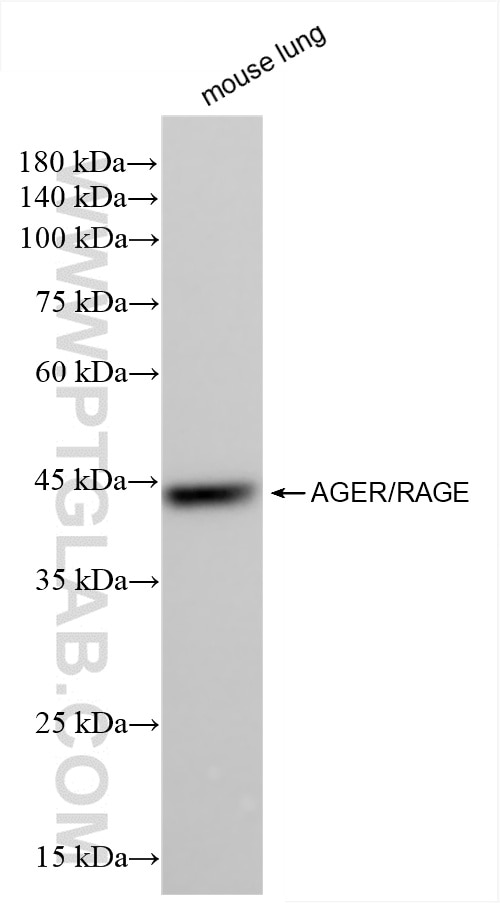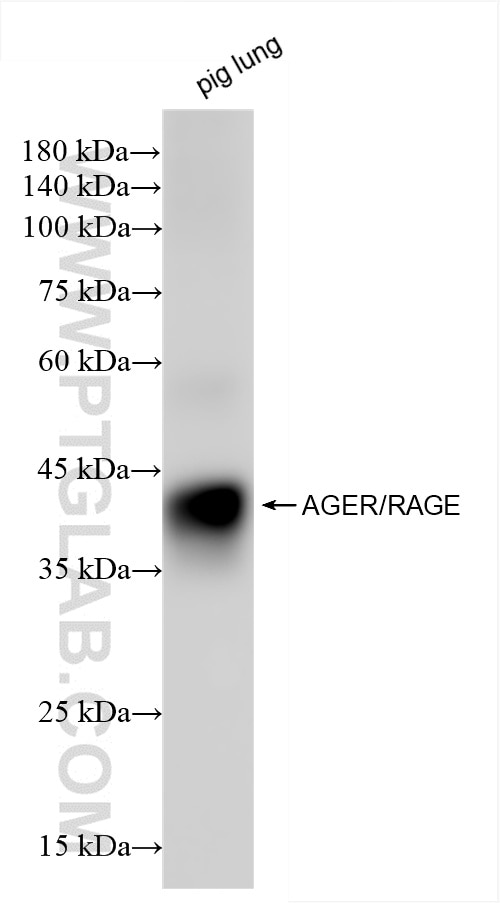AGER/RAGE Rekombinanter Antikörper
AGER/RAGE Rekombinant Antikörper für WB, ELISA
Wirt / Isotyp
Kaninchen / IgG
Getestete Reaktivität
Hausschwein, human, Maus
Anwendung
WB, ELISA
Konjugation
Unkonjugiert
CloneNo.
242714G12
Kat-Nr. : 85349-1-RR
Synonyme
Geprüfte Anwendungen
| Erfolgreiche Detektion in WB | Mauslungengewebe, Hausschwein-Lungengewebe |
Empfohlene Verdünnung
| Anwendung | Verdünnung |
|---|---|
| Western Blot (WB) | WB : 1:5000-1:50000 |
| It is recommended that this reagent should be titrated in each testing system to obtain optimal results. | |
| Sample-dependent, check data in validation data gallery | |
Produktinformation
85349-1-RR bindet in WB, ELISA AGER/RAGE und zeigt Reaktivität mit Hausschwein, human, Maus
| Getestete Reaktivität | Hausschwein, human, Maus |
| Wirt / Isotyp | Kaninchen / IgG |
| Klonalität | Rekombinant |
| Typ | Antikörper |
| Immunogen | AGER/RAGE fusion protein Eg3860 |
| Vollständiger Name | advanced glycosylation end product-specific receptor |
| Berechnetes Molekulargewicht | 404 aa, 43 kDa |
| Beobachtetes Molekulargewicht | 43 kDa |
| GenBank-Zugangsnummer | BC020669 |
| Gene symbol | AGER |
| Gene ID (NCBI) | 177 |
| Konjugation | Unkonjugiert |
| Form | Liquid |
| Reinigungsmethode | Protein-A-Reinigung |
| Lagerungspuffer | PBS with 0.02% sodium azide and 50% glycerol |
| Lagerungsbedingungen | Bei -20°C lagern. Nach dem Versand ein Jahr lang stabil Aliquotieren ist bei -20oC Lagerung nicht notwendig. 20ul Größen enthalten 0,1% BSA. |
Hintergrundinformationen
The receptor for advanced glycation end products (RAGE) is a cell surface transmembrane multiligand receptor, also known as Ager, is a multiligand member of the immunoglobulin superfamily. It has many isoforms and is predominantly expressed in the lung. AGER expression is upregulated in many diseases such as Alzheimer's disease, diabetes mellitus, atherosclerosis, and rheumatoid arthritis (PMID: 35099614).
Protokolle
| PRODUKTSPEZIFISCHE PROTOKOLLE | |
|---|---|
| WB protocol for AGER/RAGE antibody 85349-1-RR | Protokoll herunterladen |
| STANDARD-PROTOKOLLE | |
|---|---|
| Klicken Sie hier, um unsere Standardprotokolle anzuzeigen |



